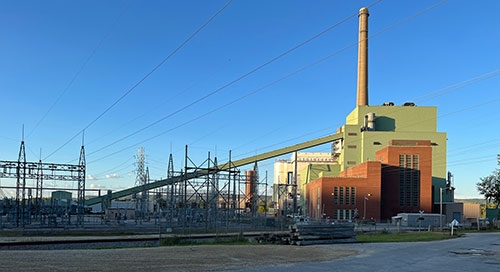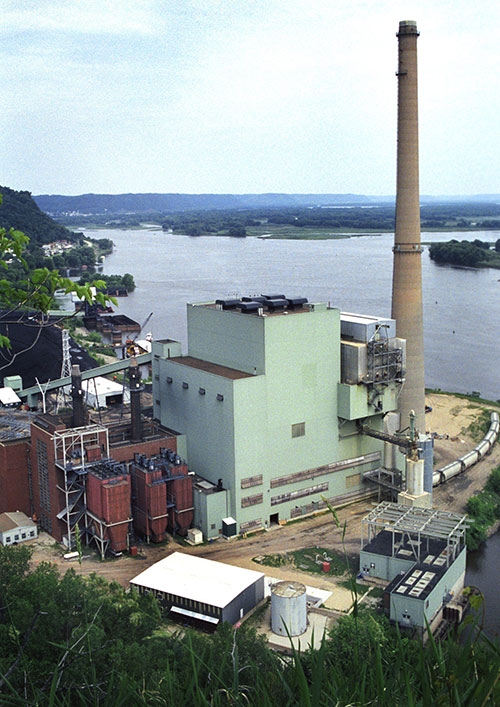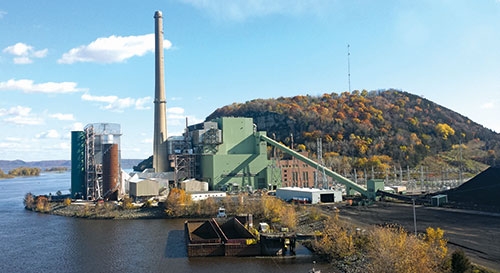You are here
Home ›End of a powerful era: Lansing Generating Station approaching its final days as Alliant Energy transitions to its clean energy blueprint

Powerful presence for nearly 75 years coming to a close ... The Alliant Energy Lansing Generating Station located just south of Lansing will be taken out of production and closing its doors as the year 2022 transitions into the new year. The plant originated in 1948 and at one time included four production units, three of which were retired from service during the timeframe of 2006-2013. The fourth and final unit will be retired at year’s end and the demolition and clean-up of the plant will take place throughout 2023 and 2024 as Alliant Energy transitions to its clean energy blueprint that intends to have all of its coal-fired power plants, such as the one in Lansing, retired by the year 2040. Photo by Susan Cantine-Maxson.

Part of the Lansing area landscape for nearly three quarters of a century ... The Lansing Generating Station, pictured at right looking north toward Lansing and pictured below looking to the south, has been a long-time industrial icon within the more natural landscape of the bluffs and river valley just south of Lansing for nearly 75 years. The facility is being retired from production and will be closed as this year transitions into the new year of 2023, with demolition of the plant facility and removal of its equipment to take place throughout 2023 and into the year 2024 as the site is planned to be returned to its more natural state by Alliant Energy. Photos courtesy of Alliant Energy.

Find some reflection by family members of some early and long-time employees of the Lansing Generating Station here.
by Susan Cantine-Maxson
As winter begins to make itself known around the Driftless region, residents cozy up in their homes, turn on the lights a little earlier than the day before and are thankful for consistent electricity which is supplied by Alliant Energy throughout Wisconsin and Iowa.
For many years, the Lansing power plant has been a significant contributor to the creation of that electricity, but the need for cleaner energy is changing the face of how that power is created. Coal-fired plants such as the one in Lansing are being phased out quickly. Alliant Energy hopes to have all of its coal-fired plants retired by 2040 and be a totally clean energy resource by 2050, relying primarily on solar and wind energy.
In October 2020, Alliant Energy announced its clean energy blueprint which is the company’s road map for accelerating transition to cleaner renewable energy. The purpose of this transition, according to Alliant Energy spokesperson Morgan Hawk is to, “enhance economic and environmental issues and to increase use of renewable energy by reducing emissions.”
“Included in this plan is the need to retire the Lansing plant by the end of 2022,” Hawk shared. “We plan on transitioning to renewable resources like wind and solar to create a healthier environment and reduce carbon dioxide emissions. Alliant’s goal is to eliminate all coal use by 2040 with net zero carbon dioxide emissions by 2050. We have been building several wind and solar farms across the region.”
“Alliant Energy is the third largest utility owner/operator of wind power in the United States,” Hawk further explained. “We are currently working on repurposing the Duane Arnold plant in Linn County into a solar project facility by utilizing the same land and transmission lines. We are repurposing a former coal-fired plant in Burlington to a natural gas facility, but there are no plans to repurpose the Lansing plant.”
The familiar light at the top of the smokestack will no longer be a part of the night sky around Lansing within the next year, as the plant is scheduled for complete demolition starting in 2023.
Twenty-four individuals were recently listed as employees at the plant. Several of those employees may retire; some may relocate to another plant. Ten years ago, the plant employed 55 people. But as the plant is gearing down, fewer employees are needed to run the facility. In the facility itself, a variety of jobs were needed such as employees that work in the coal yard, machine operators, maintenance, management, lab technicians, environmental, and safety people.
THE BEGINNINGS
Interstate Power Company built the Lansing plant in 1948. The location was chosen because of its proximity to both the river and the railroad. At its highest usage, the plant included four units (pieces of the power plant). Unit #1 was in service beginning in 1948 and was retired in 2006 (it generated 15 megawatts of power); Unit #2 began operating in 1948 and was retired in 2010 (it generated 11.5 megawatts of power); Unit #3 started in 1957 and was retired in 2013 (it generated 37.5 megawatts of power); Unit #4 began in 1977 - and is the last unit that will be retired this year. Unit #4 generates 275 megawatts of power which goes onto the power grid and serves customers throughout the region.
The Lansing plant has burned from 400,000-800,000 tons of coal per year. In 1999, three utility companies, including Interstate Power Company, merged forming Alliant Energy. Since 2010, Alliant has invested 250 million dollars to reduce emissions from the plant, which enabled the plant to comply with environmental regulations.
Once coal is delivered to the power station, it is transferred to a boiler which burns it to produce steam. The steam is transferred to a turbine; the turbine spins a generator to create electricity. Then the steam is condensed back to water and returned to the boiler to help burn more coal, and the process begins again.
Once the electricity enters the power grid, an organization called the Midcontinent Independent System Operator (MISO) supervises the transmission of electricity from Louisiana to Canada, making sure the right amount of electricity is generated to meet customers’ needs.
The website MISOenergy.org shows how all the energy is distributed. This group allows different utility companies to work together, especially in extreme weather events, so that the various utilities can assist each other. The final date for the Lansing power plant will be determined by MISO because that date will be determined by how often MISO calls Lansing into service, which will affect how fast the remaining inventory of coal is used. The plant will continue to operate as long as it is generating electricity.
Spokesperson Hawk clarified in a Friday, November 18 statement that the Lansing Generating Station will not generate electricity after December 31, 2022. “The exact date the facility stops generating electricity will be very close to the end of this year,” he shared. “We are evaluating options for the remaining coal we may have after the facility is no longer generating electricity.”
BEGINNING OF THE END
Crews have been working on the closure of the coal ash ponds at the facility. Alliant is working closely with the Department of Natural Resources (DNR) and the Environmental Protection Agency (EPA) to make sure that the area is safe, and groundwater is protected. This will continue through 2023.
Significant demolition of the building will not take place until 2023 after the plant has stopped generating electricity. Years 2023 through 2024 will see the removal of materials and equipment and debris, plus final site restoration.
Hawk emphasized, “Alliant plans to keep the community informed and work in partnership with local officials and other stakeholders. Alliant owns the property, except for one acre leased from the Iowa DNR. Alliant wants to restore the area to what it was before the plant was there. We want to be a good community partner.”
“We support numerous organizations and projects through the Alliant Foundation which promotes economic development, school groups, fire departments and similar programs such as scholarships,” Hawk further shared. “Alliant will continue to do that. We focus on hunger, housing, workforce readiness, diversity, safety, organizations and causes. People who wish to apply for grants should explore our website: alliantenergy.com/foundation. Alliant recognizes the economic impact it has to the area and is committed to serving customers and supporting the community moving forward.”
The work on the coal ash pond is scheduled to be completed by October 2023 and will be done according to DNR and EPA guidelines, which allows for material to be closed in place under an engineered cover system. People driving by the current plant and ponds will notice very large black tunnel-like bags along the edges of the ponds. Hawk explained the purpose of those bags in the clean-up process as follows:
“Those are geotextile tubes. Material is being hydraulically dredged from the coal ash pond and sent to the geotextile tubes for dewatering purposes. The geotextile tubes are perforated, allowing water to filter through the perforations, leaving relatively dry coal ash material behind. The filled and dewatered geotextile tubes will remain in place, under an engineered cover system, as part of the coal ash pond closure. There will not be any area designed to hold water following the pond closure. The south end is planned to be a grassy hill. The north end is planned to be a flatter area that will be sloped to allow rain to flow out. The EPA requires the site to be monitored and maintained for at least 30 years. We are fully committed to meeting our obligations and to addressing any environmental impacts that are identified.”
Hawk concluded that it is too early to discuss future uses of the site but noted, “we are evaluating several options that are in the best interest of our customers and the community.”
CLOSURE IMPACT
When a county loses a power plant such as the Alliant plant in Lansing, many people are affected by that loss. Not only do people lose jobs, but there is also a loss of money related to taxes for the entire county. Because of the complexity of the types of taxes and distribution of taxes, it is difficult to estimate the overall impact on the county. Because of the reporting dates, most adjustments will not occur until September of 2024.
According to the Iowa Department of Revenue, companies which are subject to the Iowa replacement tax are taxed based on deliveries of electricity, deliveries of natural gas, generation of electricity and the number of transmission lines on their property. The total replacement tax is allocated among all local taxing jurisdictions where a taxpayer owns utility property.
Iowa Code section 437A.15 gives additional information on the allocation of replacement tax dollars. Taxed entities submit an estimation of their usage October 1 of each year. Anything changed after October 1, such as the decommissioning of a power plant, will not be reported until the following October. Taxes would not be affected until the next September following that reporting.
Allamakee County Assessor Ann Burckart further explained the tax distinction as it applies to Alliant Energy: “Alliant does not pay a property tax, but they do pay a tax on how much power they produce, which is determined by the Iowa Department of Revenue. Central assessments are determined by the State. The assessment is sent back to the County.
We have no way of knowing exactly how much value will be removed from the central assessment with the closing of the Alliant plant.
“Currently, the central assessment is about $47 million in value from the plant when it is fully functioning. If they produce no power, most of the value will all go away. Value due to transfer stations and transferring electricity through power lines will remain. They will still be relaying electricity. In the last assessment allocation, the County received over $1 million. That number will decrease but it is unlikely that we will lose all of it. All taxing bodies that levy on total county taxable value will be affected as well. Those levies include funds for the following entities: the county, school, ag extension, the assessor, NICC, the fire department, the ambulance department, the library and the fund for tuberculosis & brucellosis eradication.”
Alliant spokesperson Hawk added, “Alliant Energy will continue to pay taxes in Allamakee County following the retirement of the Lansing Generating Station. After the facility stops generating electricity, Alliant Energy will work with the County to value the property for tax purposes. When the Lansing Generating Station stops generating electricity, it will no longer be included in the centrally-assessed tax equation. However, Alliant Energy will still own electricity distribution property (electric lines, etc.) throughout Allamakee County, so our centrally-assessed tax burden in the county will not completely go away. In 2023 - after the Lansing Generating Station stops generating electricity - Alliant Energy will work with the County to value the remaining property under the locally-assessed taxation.”
Superintendent Dr. Dale Crozier confirmed that the Eastern Allamakee Community School District has been planning for this possibility for several years, beginning when Alliant first mentioned the possibility of closing; the district began double-paying on bond installments so that the bond would be paid off by the time the plant closed. Therefore, when the allocation decreases, the district will have the money that it was using to pay for the previous bond payments to make up the difference because of the loss. Because of this pre-planning, there should not be a significant impact on the district.
Crozier has stated, “School districts are financially driven by enrollment, not property valuation. Eastern Allamakee currently has a strong unspent balance, we have maintained our solvency, and there is no reason to panic. We must continue to be diligent and continue to find creative ways to maximize our resources. The Iowa school equalization formula, which generates state aid, would cause the revenue we lose in the general fund from Alliant to be replaced. The school would lose no money in the general operating fund. Eastern Allamakee is one of a handful of districts with a power plant. In each case the valuation towards the school is capped (by state action) at approximately 41 million dollars, which constitutes only about 18% of the district’s total valuation.”
“The main necessity and goal of Eastern Allamakee is to maintain enrollment,” Dr. Crozier further offered. “The largest loss of Alliant Energy to our community would be any economic development, and future families that might have had children. Our future task is finding ways to gain families who want to live and raise their children in a nice small town. I am not going to say that taxes will never go up, because if people want to keep their school they need to understand that they will need to keep funding it. However, Alliant’s closure will not be any type of factor in the longevity of the school district. The primary funds we receive from the State are based on enrollment. We will be fine!”
Lansing Mayor Melissa Hammell expanded on the closure: “The loss of an employer for Lansing is probably going to be the biggest impact for our community. Economically, the City of Lansing is not supposed to be too heavily affected, but that will have to be seen over time. I have hope that the land can be well utilized.”
So, as fall turns to winter and the Driftless Area becomes covered in snow, residents will turn up the heat, thankful for electricity and all the benefits it brings to creature comforts and necessities. But now, that power will be transported from some other generating station because the Lansing plant will be dark and silent. The great Mississippi River will continue to flow past in the spring again, reclaiming the land as its own.

